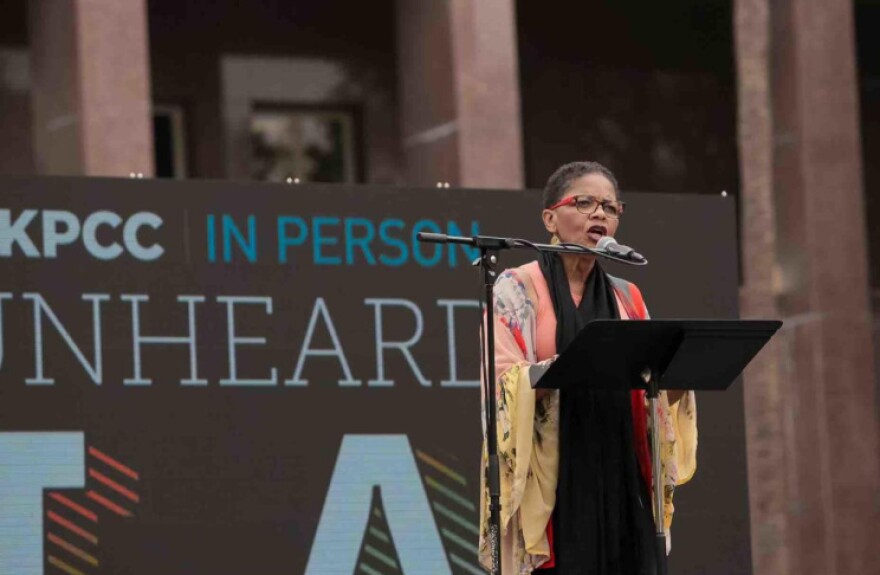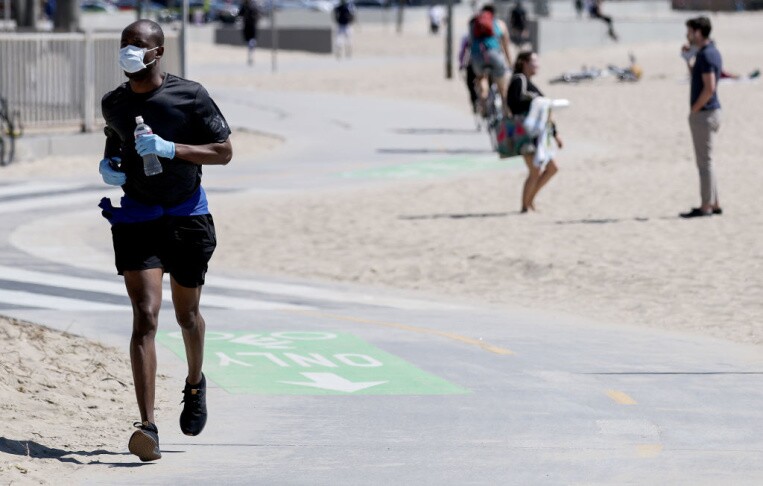Truth matters. Community matters. Your support makes both possible. LAist is one of the few places where news remains independent and free from political and corporate influence. Stand up for truth and for LAist. Make your year-end tax-deductible gift now.
Jogging While Black: I Tried Everything To Look Less Threatening, And 'Still They Crossed The Street'

Listen to the radio version of this essay:
I was born and raised in South Los Angeles, but I have also lived where there are very few African Americans. I've been in Thousand Oaks for more than a decade. Before that, I've had homes in Glendale and also in Lancaster, Penn., which is known for its Amish community.
Race in LA
From June 2020 to July 2021, we published your stories each week to continue important conversations about race/ethnicity, identity and how both affect our lived experiences. We now have a new series Being American, which is again soliciting your essays.
Read:
The pattern of living where I rarely see black people is unintentional on my part. For reasons of work mainly, my family has lived where we are often strangers (or strange-looking) to others in our hometown.
I've adapted to being the odd man out, with a routine for leaving the house. I grab my keys, cellphone, and water bottle, and I put on "the face" of normalcy. That face expects suspicious looks from sales clerks as I enter a shoe store where I've been a rewards member for 13 years. The face ignores subversive comments from white co-workers when I get a little too much attention for doing my job well. The face shields my children from a swastika flag hung on a neighbor's balcony in plain view of our backyard. Sadly, the face becomes an overused mask, providing little protection from demoralizing assaults to human dignity.
MORE FROM OUR RACE IN LA SERIES
- Black And Tired In This American Newsroom
- Conflicted: A Black Journalist's Reckoning With Her Race, Family And Police Brutality
- How To Participate In Our Series
And so I have found a different type of community for support. It's a community defined by race, gender, and age. I live in the Sistahood of Black Women over 50. We are experts at code-switching to present a non-threatening countenance to people who don't know us.
One personal example of code-switching comes from when I lived in Glendale in the mid-1990s. We had a lovely Spanish-style home near the foothills, and I so enjoyed the tree-lined streets and well-manicured lawns. I made a habit of jogging in the area on Saturday mornings.
For most runs, I threw on sweatpants, a T-shirt, and a baseball cap. But as I soon realized, the sight of a black person running toward folks made them change route, as if they had a primal urge to do so.
I wondered if it had something to do with the side of the street I was on. So I experimented, starting my run on the opposite side of the street. Still, it happened.

I tried dressing up for my runs. I bought coordinating jogging outfits and ran without a cap. I even put on makeup for a smoother complexion and tiny earrings to signal to people I was a woman, maybe less of a threat.
Still, they crossed the street.
One time, a woman pulled her Mercedes to a corner mailbox on my side of the street and exited her car. Then, as she saw me approaching, she turned around and activated her car lock. The loud chirp was a signal that I made her uncomfortable.
I was tempted to wear a sandwich board sign during my jogs that read, "I'm no threat. I have a large mortgage here. I'm current on my payments."
My experiment continued. I decided to walk instead of run. In addition, I invited a white female friend to join me. I didn't let her in on my undercover strategy.
To my surprise, not one person crossed the street. Many of the passersby greeted us, "Good morning!" "Nice day for a walk!" And as I recall, I even got close enough to compliment one woman's beautiful baby in a stroller.
When I clued in my walking partner to the experiment, her take was, "Oh, you're being hypersensitive. I can't believe it makes a difference if you're white or black to exercise."
When I told the story to a sista, her response was, "Uh-hum." Code for, "Girl, you got that right." Within the Sistahood, there's no need to explain the triple whammy of race, gender, and age as a load to carry.
That jogging experience was more than 25 years ago. These days, the behavior of people crossing the street as I approach is occurring for different reasons. I walk with my face covered due to COVID-19 and ironically, fear-based behavior keeps me safe from the virus.
The protests of recent weeks expose what I have quietly experienced for decades. But I get no satisfaction in the proverbial I-told-you-so. I wasn't imagining it, I wasn't paranoid, and I wasn't an alarmist. Racism is real.

My heart sank when I learned about Ahmaud Arbery, a black jogger who was killed this year while on his exercise route. Jogging while black. Being while black. Videotaped while black. I often think of Ahmaud's mother and send prayers up for her comfort.
The Sistahood represents a legacy of women who thrive in the face of negative racial stereotypes. We have a collective resolve that influences political outcomes, effects social change, and just as important, we manage households.
We have many accomplished members, some of whom are known by their first name only. I call them the Great O's: there's Oprah, and Vi-O-la, and Michelle O-bama. Pioneers include Anita Hill whose 1991 congressional testimony first brought to light sexual harassment in the workplace. And there are millions of my community members who live without celebrity. We are business owners, philanthropists, scientists, and hold just about any profession you can name.
And we are actors, not always by profession, but by nature. By necessity.
We are unsung heroes as nurturers from way back. Our community was counted in U.S. labor statistics long before blacks and women could even vote. Why? Because our mothers' mothers' mothers were nannies to other people's children.
Yet we carry the load as role models for our sons and daughters. We use hope as a noun, that deep-in-your-bones belief that things will be alright. It allows us to show grace to those who fear the unfamiliar, even in a richly diverse Los Angeles.
* * *
This essay is an update to the KPCC Unheard LA story performed at the Nate Holden Performing Arts Center in February 2018. To view the video, click here.
ABOUT THE AUTHOR:
Cheryl Farrell is a corporate communications consultant and performance storyteller in Southern California. She has more than three decades of experience in healthcare, education, and financial services. Cheryl was an original cast member of the Jeopardy! Clue Crew (2001-08) and toured the world appearing in more than 1,000 video clips. She is developing a book proposal that examines how older black women excel at the intersection of race, gender, and age. Cheryl has a master's degree in communication management from USC and a bachelor's degree in economics from UCLA. She has been married for 35 years and has two adult children.







